How to make a guinea pig cage with your own hands?
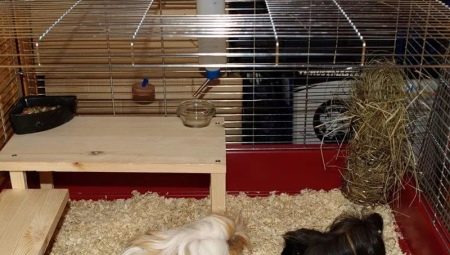
For a guinea pig, you can buy a cage in a special store, because there is a huge selection of such devices. But if you can't find a suitable cage for your pet, then you can make it yourself.




Pros and cons of homemade cages
There are advantages and disadvantages of a DIY cage.
The pluses include the positions described below.
Saving money - It is better to make your own home than to spend money in a store and purchase a small cage. To save even more money, you can use a fleece mat - it is quickly cleaned and set in place.
If you make yourself a cage for a rodent, then the pets will be healthy, cheerful and happy, because homemade construction will not become small for them, and the animal will not have restrictions on movement.
If there are several pets inside the cage, then the dwelling made can give them more territory for privacy.




You can also create unique, multi-level, L-shaped designs. There are many options for creativity.
You can use almost any materials and elements. From building materials that are prepared for housing an animal, you can make a food part, a feeder and a house. If there are lattices, then you can prepare bunk beds. It is necessary to bend them and fasten them with ties to the edges of the dwelling.
Self-made cage is easy to clean. If you make a large and open structure, then you can clean everything well and replace the bedding.A homemade cage does not need to be disassembled - it will not have hard-to-reach parts.




Of the minuses, it is worth noting the fact that in the absence of knowledge of all the rules and recommendations for designing a home made with your own hands, it can become unsafe for a rodent.
You should first find out from what material the cells can be made, how to fix them correctly. If this is not done, then the rodent can be injured and hurt.
Primary requirements
Before making a cage with your own hands, you should consider the size of the housing. A small table of standard rodent design sizes can be drawn up.
For one rodent, the size of the cage should be 80 × 110 cm, for two - 80 × 150 cm, for three - 80 × 180 cm, and for four - 80 × 220 cm.
If you want to make the territory larger, then you should add a little footage so that the animals move freely throughout the free space.

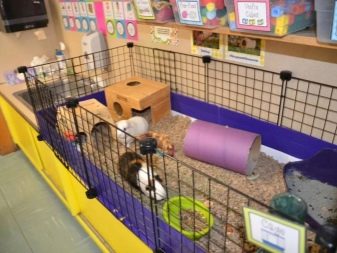
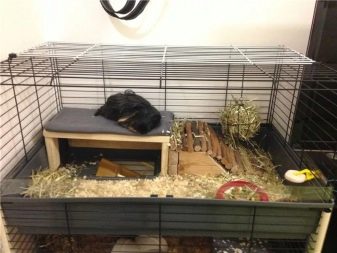

Before designing a home, you need to know certain conditions.
- The area where the rodent will be kept must be dry and clean and have adequate ventilation.
- In order to have more contact with your pet, you need to make a house in a room where the whole family will gather. The pet is easily adaptable if it hears human speech.
- The dwelling must be installed on a flat, smooth surface so that there are no slopes or wobbly areas.
- The pet's dwelling must be level so that the pet is not injured.
- The height of the house should be about 36-41 cm. If the rodent is large and, standing on its hind legs, can reach the upper wall of the dwelling, then the height must be increased.
- If there are other pets in the apartment, then the animal's dwelling should be constructed directly under the ceiling. The ceiling will be able to protect the pet from other aggressive pets, moreover, in this case, any things will not fall on it from above.
- If the pet is already several years old, then it does not need to make a cage for it, which has many levels.
- All walls and floors in the house should be well lit. It is better if it is natural light.
- Do not install a dwelling near heating appliances. Also, the cage must be installed at least 52 cm from the outer walls of the house.

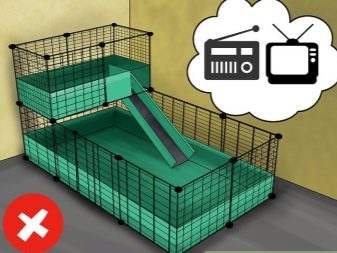
Required materials and tools
To start building your own pet cage, you must have the materials and tools described below.
- Corrugated board with many layers. You can take it out of the box or packaging of household equipment. In order for the cardboard to be waterproof, it must be pasted over with wide tape on the inside - this way all places will be protected from water. You can also cover the inside of the prepared box with acrylic or fiberglass. This material is well suited for the construction of pet cages. It is easy to process if you need to bend the edges of the cage at an angle of 90 degrees. Corrugated cardboard is a lightweight and highly durable material. There are many colors, but if the required color is missing, then the cardboard should be pasted over with tape of the required color.
- Lattice, made of metal, should have cells measuring 3 cm for a large pet and 1 cm for a small one. You can buy a grid that is the correct size at a hardware store or in the market.
- Stationery knife.
- Ribbon, which can be glued.
- Scissors.
- Ruler or a tape measure.
- Pencil.

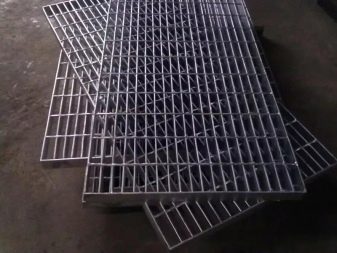


Step-by-step instruction
Before making the structure, you need to choose the dimensions for the home. If there are several sea rodents, then you need to make a large dwelling.
If there are pregnant women or small pets inside the cage, then they need to be equipped with additional protection along the edges of the dwelling.
It is necessary to choose the dimensions with a rectangular section. The size of the bottom base will depend on the size of the rodent's dwelling.
The recommended height is 16 cm.
The cage can be constructed according to the scheme presented below.
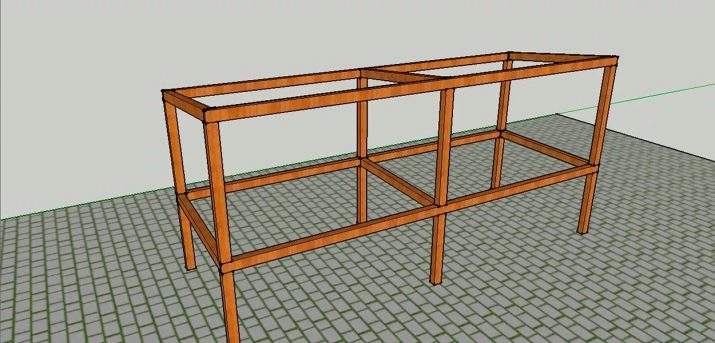
It is necessary to draw the lower part of the future home on cardboard. To make the sides, you need to measure a distance of 16 cm on each side and connect them with lines. Corrugated board can have 2 layers and air pockets between them. By cutting through the top layer, you can bend the corrugated board 90 degrees. On its first layer, you need to make an incision, then cut out the sheet, assemble the box and glue it with tape. Then you need to fold the edges. To do this, bend the protruding edges of the sides to the opposite part and, using adhesive tape, glue them together.
As a result, you should get a rectangular box without a top.

Now you need to assemble the walls from metal gratings - they will go along the perimeter of the rodent's dwelling.
Panels need to be cut out of them. The panel should be twice the height of the box itself. So that the individual is not injured, it is necessary to process the edges of the panels. Use cable ties to connect the panels. The ends of the cable ties should be cut off. Each side must be collected separately. The length of all sides must be appropriate.

Now you need to attach the cardboard box to the grates.
Using cable ties, the edges of the sides must be joined together. You also need to tie the edges on the top, bottom, and center. The angle you get should be right. You cannot tightly attach the sides to each other, since this makes it impossible to connect the sides on the opposite side of the cage.

How to equip?
Items inside the dwelling should be well attached to the walls or located on the floor. Inside the cage, it is necessary to place a drinker, a feeder, a hay tray, toys, wooden sticks. Also, a place for solitude must be provided for the animal.
With the help of a drinker, the individual will not spray water on the litter and will not be able to get wet. The volume of the drinker may depend on the number of pets inside the cage. If there are a lot of animals, then you can use several drinkers, which are small in size.
Also, inside the dwelling of the individual, there must be an area for food. It is necessary to purchase several feeders in order to pour various types of feed. Foods that are green, juicy and tough should be placed in different troughs.


For a rodent that lives at home, conditions are needed that are similar to natural ones. For a pet you need rough materialsso he can grind his teeth. Inside the cage you need to put twigs, but do not lay branches from conifers. Branches that have large bones inside the fruit must be dried in advance. You can also put inside the cage mineral stone.
You can arrange hanging accessories, as they will not cause injury to the pet if they are correctly installed and secured. For example, you should take a closer look at the hammocks on which sea pets can relax.
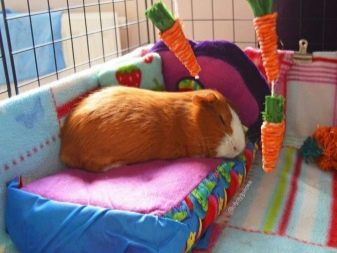

The animal is shy and shy. Next to caring people, the individual will become more sociable and brave. But a pet still needs a site so that it can retire. Inside the cage you should equip a secluded corner, for example, a house.
If there are many rodents inside the cage, they will fight for it. Instead of a simple house, you need to put up a canopy or fence off the whole cage with good material. Another option is to put a pipe made from pressed hay.
If the guinea pig is constantly hiding inside the house, then it will be impossible to tame it, since inside it the animal can feel isolated and cannot see people. So that the pet can get used to the person, the house needs to be temporarily changed to a handful of hay.


You should buy toys for the animal so that the guinea pig can have a little fun. With the help of toys, the pet will be able to quickly master the entire territory of the cage. For the animal to move more, you need to constantly change toys.
If you put a ball of hay in a cage, then many rodents will be able to pull straws out of it. But this design will not be convenient for eating. You can put both a special tray and a ball.

These pets feel comfortable in a territory that looks like a burrow. For this reason, it is necessary to purchase toys that are in the shape of a pipe. If several animals live inside the cage, then you need to purchase several pipes. Pipes can serve as hiding places if pets conflict with each other. Also pipes and labyrinths can make your pet's life more interesting.
The animal may be interested in various labyrinths for a long time. The main thing is that the rodent is active, as this has a good effect on the health of the pet - it will not be obese.
Thus, the cage is the most important component for the mumps. It is important to make the right home for the pet and equip it comfortably.


How to make a cage with your own hands, see below.








